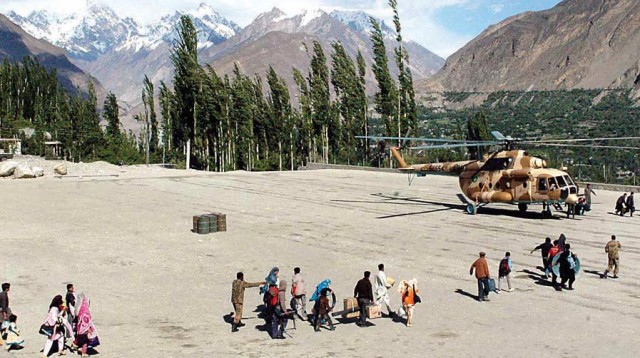
Assistant Commissioner Hunza, Zamir Abbas told The Express Tribune that water from the lake would start emptying out through the spillway soon.
The government shifted displaced people settled in about 400 camps downstream to safer locations on Thursday, declaring the camp area too dangerous for habitation.
The Deputy Commissioner Hunza Zafar Taj told reporters that IDPs residing in camps at Faizabad had been shifted to higher ground because the government felt they were not in a safe enough position in the event that a flash flood occurred. Taj said that arrangements to respond to an emergency had been completed, adding that authorities were hopeful that the impact of the lake when it overflowed would not be as devastating as had been feared.
He also said that people had also been warned not to visit danger areas.
Meanwhile, traffic on the Karakoram Highway from Gilgit to Hunza has been suspended for an indefinite period in view of a possible breach of the Attabad Lake, Abbas said. “The decision has been taken to ensure the safety of passengers,” he said.
Lieutenant-General (Retd) Nadeem Ahmed, Chairman of the National Disaster Management Authority (NDMA), told reporters in Gilgit that the government had spent Rs350 million on relief efforts since the disaster struck Hunza.
He said the NDMA was setting up a hotline control room which will be manned around-the-clock. “The hotline’s number will be flashed across TV screens so that people’s difficulties can be addressed immediately,” he said.
Ahmed said the government will soon launch a Business Revival Loan Programme for those people in Gulmit who lost their businesses to the expanding lake.
Also on Thursday, a representative body calling itself the ‘Coordination Committee Gojal’ threatened to launch a civil disobedience movement against what they termed the “government’s atrocities towards the affectees of Attabad and Gojal.”
During a press conference, the group demanded that Gojal be declared a calamity-hit area and called for compensation. They said their areas had run out of food, medicine and other basic amenities. The group threatened that they would begin a long march towards China seeking help. The speakers accused the government of harassing people from Gojal for voicing their demands.
Published in the Express Tribune,May 28th, 2010.
1732503274-0/Untitled-design-(43)1732503274-0-405x300.webp)
1732501636-0/Untitled-design-(42)1732501636-0-165x106.webp)

1732498967-0/Outer-Banks--(1)1732498967-0-165x106.webp)
1732086766-0/BeFunky-collage-(74)1732086766-0-165x106.webp)












COMMENTS (2)
Comments are moderated and generally will be posted if they are on-topic and not abusive.
For more information, please see our Comments FAQ